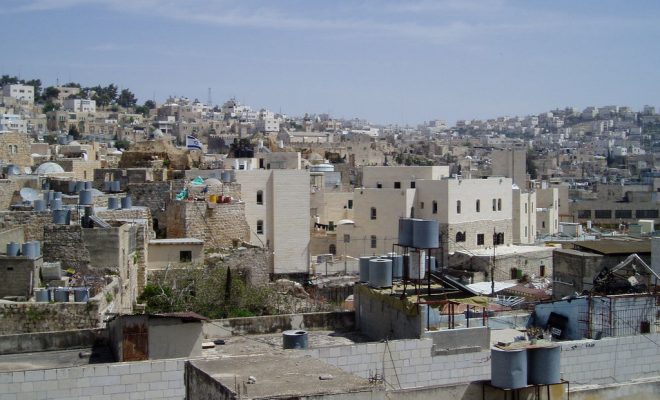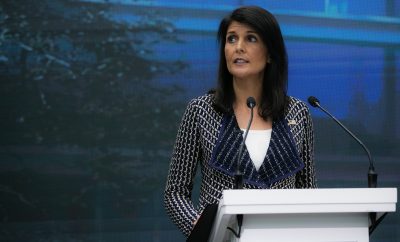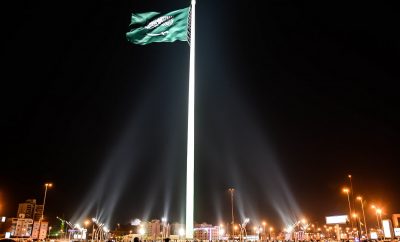 "israeli settlement in the middle of hebron, palestine" courtesy of Jordan Klein; License: (CC BY 2.0)
"israeli settlement in the middle of hebron, palestine" courtesy of Jordan Klein; License: (CC BY 2.0)
World
What a Recent U.N. Resolution Means for the Israeli-Palestinian Peace Process
The United Nations recently passed a resolution regarding Israeli settlements in occupied Palestinian lands. The most significant takeaways from this development are that the United States allowed the U.N. resolution to be passed and the specific language included in the resolution. This is particularly true when coupled with the language used by Israeli Prime Minister Benjamin Netanyahu to criticize the United States and President Barack Obama after the resolution’s passage. Read on to find out what exactly the resolution means for Palestine, Israel, and the United States as well as the history of the conflict that led to the resolution in the first place.
The Resolution
So what does this resolution do and why has it made the leadership of Israel so upset? The U.N. resolution declares that Israeli settlements are a violation of international law and calls for an immediate end to all settlement activities. The actual determination in the resolution is nothing new, in fact, it has been the view of the international community for some time. What is new is that the Obama administration allowed it to pass without vetoing it as well as the emerging context surrounding the dispute–many are now starting to doubt whether the long sought after two-state solution is still a viable option.
After the resolution was passed, Palestinian leaders indicated that they would use the resolution to support their case against Israel in international courts, a move strongly opposed by Israel. While the condemning language and the reaction of Palestinian leaders are significant, they pale in comparison to accusations leveled by Israeli Prime Minister Netanyahu against President Obama. Netanyahu has effectively accused Obama and his administration of plotting against Israel and even crafting the resolution in the first place, which the Obama Administration denies.
The resolution that did pass is not actually binding; while it may condemn Israel’s actions it cannot forcibly stop them. Additionally, President Donald Trump has already vowed to veto any resolution that would actually force Israel to cease and desist settlement activities. The video below looks at the U.N. resolution:
The History of the Conflict
The origins of the conflict between the two sides go back to the 19th century. Initially, the territory in question was part of the Ottoman Empire. However, during World War I, when it was clear that the Ottomans would lose, Britain and France created their own plan for the region following the war with something known as the Sykes-Picot Agreement. This agreement effectively carved up Arab lands in the Middle East between France and the U.K., which went against earlier promises for an Arab state following the end of the war.
In 1917, the U.K. issued the Balfour Declaration, in which it announced its support of establishing a Jewish homeland in Palestine. British responsibility for creating an Israeli homeland was reaffirmed by the Palestinian Mandate in 1921, which gave it control over former Ottoman lands along the terms agreed upon in Sykes-Picot. However, neither the mandate nor the earlier Balfour Declaration mentioned anything about creating a Palestinian homeland, despite the wishes of the Palestinian population.
This resentment, coupled with earlier broken promises to create an independent Arab state and the continuing and increasing Jewish migration, led to persistent conflict. In the 1930s Jewish militias helped the British put down the Arab uprising hoping to rekindle support for their independent state. Instead, they were betrayed again by yet another British agreement known as the White Paper of 1939, which would limit further Jewish migration, even as the Holocaust occurred in Europe.
After World War II the British ended its mandate in the area, transferring the land and the problems that went with it to the United Nations. The U.N. then attempted a two-state partition that instead led to more fighting and eventually the first Arab-Israeli War, which ended with an armistice in 1949. Per the terms of the agreement, Israel took control of 77 percent of the original mandate, Jordan received control over the West Bank and East Jerusalem and Egypt acquired the Gaza Strip, Palestinians did not control any territory following the fighting. This also led to a mass exodus of Palestinians and a huge refugee problem that continues to this day. The biggest flare of violence between Israel and its neighbors after this, until 1967, was a joint British-French-Israeli effort to take back the Suez Canal after it had been nationalized in 1956.
While the root of the general conflict can clearly be traced back further, the root of the modern conflict can trace its most direct route to the 1967 war, known most commonly as the 6-Day War. After a series of Palestinian attacks from surrounding countries and Israeli retaliation, Syria, Jordan, Egypt, and Iraq started mobilizing their militaries. However, Israel then took a surprise early offensive, decimating much of its adversaries’ air force and went on to capture a dominant victory. As a result of the victory, Israel won and occupied the Sinai Peninsula, Gaza Strip, West Bank, all of Jerusalem, and the Golan Heights. In the process of the war, hundreds of thousands more refugees were forced to leave their homes and more than a million Palestinians fell under the direct rule of Israel.
Another conflict emerged in 1973 when Egypt launched a surprise attack on Israel. The attack prompted the United States to step in and seek a diplomatic resolution. After several years, Israel and Egypt signed a peace treaty that included the return of the Sinai Peninsula to Egypt.
However, since 1967, there has been an almost unstoppable pace of settlement in occupied territories by Israeli settlers. As of 2013, there were over 200 settlements and outposts of Israeli settlers in lands occupied since the end of the 6-Day War, namely in the West Bank and East Jerusalem. These settlements, even the outposts that the Israeli government considers illegal, are encouraged and supported by the government through subsidies and tax breaks on housing, education, and opening new businesses.
Apart from incentives, Israeli settlers also enjoy many other advantages over their Palestinian neighbors in the occupied territories. One is a separate legal system that greatly benefits settlers over Palestinian natives who instead are governed by military law. Another is access to resources such as water, transportation, and electricity, which settlers get from the Israeli government. The settlements have led to perpetual conflict, despite numerous efforts at peace. The following video gives a good description of the roots of the conflict:
The United States, Israel, Palestine and the History of Peace Talks
Since the end of the 6-Day War, there have been several efforts aimed at achieving peace between Israel and Palestine and establishing some framework in which both peoples can have states of their own. This started with two other U.N. resolutions, namely 242 and 338, which put an end to the 1973 War and also called for Israel to withdraw from the territories it occupied. Building off of the 1973 War were the Camp David Accords, which led to Israel withdrawing from the Sinai Peninsula and Egypt recognizing it as a state. But these talks did not involve the Palestinians.
The Madrid Conference in 1991 was aimed at similar goals, namely ensuring recognition of the state of Israel. Ultimately, it led to peace between Israel and Jordan, but none of the other combatants. While the Palestinians were represented at the Madrid Conference, the first deal to actually incorporate them was the Oslo Accords in 1993. In exchange for promising to incrementally withdraw Israeli troops from Gaza and the West Bank, the Palestinian Liberation Organization, or PLO, would acknowledge Israel’s right to exist. Opposition groups in Palestine and settler groups in Israel opposed the deal, which led to violence. The agreement was never fully implemented.
Probably the closest the two sides ever came to lasting peace was the second Camp David Accords in 2000 when both sides offered land swaps, however, they were not quite enough to entice the other to agree to a peace resolution. A last ditch effort in Taba in 2001 and an Arab Initiative in 2002 both also failed. In 2003 President Bush submitted his road map to peace and became the first president to call for an independent Palestinian state. Unfortunately, another set of negotiations, the Geneva Accords of 2003, attempted to fix the same problem from another direction. Both attempts were unsuccessful. Two more rounds of talks in 2007 and 2010 seemed close to reaching deals at times but both ultimately fell short as well.
This history led President Barack Obama to seek some positive action before his term ended. Without having to worry about reelection, he allowed the recent resolution to pass. While his actions are not unprecedented, they are still controversial. Other resolutions have been passed regarding Israeli-Palestinian relations, but this was the most recent one to condemn settlements since 1980. Additionally, while Obama is not the first U.S. president to allow a resolution related to this conflict to pass without a veto, it is the first time in his presidency. The accompanying video looks at the peace process as it currently stands and the remaining inherent trouble:
Moving Forward
While the resolution is non-binding, it is not entirely toothless. What it does is create a template for future negotiations and potentially other resolutions that would be binding. While a January 15 International Peace Conference seemed to offer a forum to draft that kind of resolution, no such progress was made. Instead, the focus was mainly on reopening dialogue between the two parties and reiterating support for past ideas, such as a two-state solution and the return of land occupied by Israel to Palestine.
Aside from creating guidelines, the recent U.N. resolution also eliminated many of the legal arguments Israel could have used to justify settlements. The resolution may also lead to subsequent efforts to apply sanctions on Israeli goods made in the occupied territories or force Israel to go to the International Criminal Court.
President Trump has already denounced the resolution and promised to repeal it. However, that seems unlikely as he would have to introduce a new resolution and, like the current one, get it through the Security Council without a single veto, which is unlikely. However, Trump and the Israelis can cut funding to the United Nations, which would be significant, as the U.S. supplies 22 percent of the organization’s budget. Israel can also go after the nations who voted for the resolution, summoning ambassadors from countries that supported the resolution.The U.S. embassy, notably, was not among those targeted by Israel.
In the meantime, the settlements continue to be built and expand further into Palestinian occupied lands. There are now 600,000 Jewish Israelis living in either East Jerusalem or the West Bank where once there were none. In other words, nearly 10 percent of the country’s Jewish population lives beyond the borders established in 1967 and in territory recognized as Palestinian.
As a result, Palestinians view these settlements as an unjust seizing of the land that they would receive if a two-state solution ever came to fruition. The Israelis view these settlements as a necessary buffer and feel justified through scripture. They also contend that since Jordan, which once laid claim to these areas of land, is no longer interested in the lands, there is no sovereign power who has control over them. However, even Israel will not go so far as to claim the disputed lands in the West Bank as part of its own sovereign territory. Any solution to the problem will likely have to include land swaps, among other things, something that Israel has shown it is not totally against, such as when it abandoned a settlement in the Gaza Strip in 2005.
Conclusion
The issues in the Israeli-Palestinian peace process are not going to be resolved by one U.N. resolution. However, that was never the point as the resolution was non-binding. The idea behind the resolution was to create some type of momentum for negotiations–or possibly block the momentum of efforts that many believe run against the interests of a peace settlement. In this circumstance, the onus was put on Israel, as the international community sought to make a strong statement on settlement building.
The likelihood of reaching an actual deal depends on more than just these two countries. While the rest of the Security Council, and the world in general, have an interest, the United States has played a key role in many past peace attempts. This U.N. resolution then could signal an important step forward if all sides involved are willing to look past politics and are serious about achieving some sort of two-state solution. However, it appears unlikely that the incoming president will take the same line on Israeli settlement building, which could cause many to question the negotiation process given that most view settlements as an important obstacle to a lasting resolution.








Comments